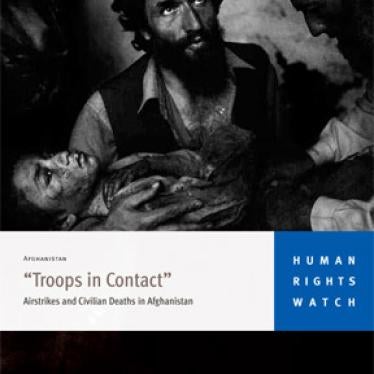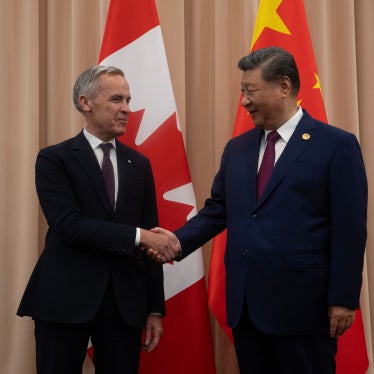(New York) - The United States should cooperate fully with Afghan police in investigating the death and alleged torture of a member of an Afghan armed faction who appears to have died at a US airbase, Human Rights Watch said today. The US should also conduct its own internal investigation and hold accountable any of its forces who may have been responsible.
Allegations about the death of the man, Agha Mohammad, were made public in a British documentary, "Afghanistan's Dirty War," broadcast on Britain's Channel 4 on June 15, 2009.
Human Rights Watch's own investigation of the death in December 2008 in Herat province in western Afghanistan, and an autopsy report show strong evidence of torture. Mohammad's body was recovered wearing an orange jumpsuit of the kind worn by detainees held by the US in Afghanistan. Human Rights Watch said that this and other episodes should cause US military commanders in Afghanistan to reconsider their relationships with abusive armed groups.
"The death and alleged torture of a detainee who had been on a US air base is a gravely serious matter," said Brad Adams, Asia director at Human Rights Watch. "The US needs to cooperate fully with the Afghan police in their investigation and to open an internal investigation of its own to get to the bottom of this."
There is no indication that US forces are actively providing assistance to the Afghan investigation or pursuing an internal investigation, even though criminal offenses may have taken place on a US base.
Afghan and US officials gave differing accounts as to whether Afghans who had been working at the base at the time of the incident could be questioned. The chief of Afghanistan's Criminal Investigation Department for the western region, Ali Khan, said that three requests have been made to US Special Forces to hand over suspects for questioning, but each request has been refused. Khan told Human Rights Watch: "The US Special Forces told me that the three Afghan suspects are working as security guards for them, therefore without the approval of US Special Forces in Bagram headquarters they cannot hand them over to any organization."
A legal representative for US Special Forces in Shindand told Human Rights Watch, however, that the Special Forces have not prevented the arrest or questioning of any individuals and that the matter is a purely criminal one for the Afghan police.
Afghan sources told Human Rights Watch about a conflict between two armed factions on December 29, 2008. At about 5 p.m., a group loyal to Gul Agha attacked a group loyal to Mohammad Nader in the village of Kalas in the Shindand district. Earlier that day, Nader's men had killed Agha's son. Soon after the fighting began, Afghan National Security Forces (ANSF) and a small number of US Special Forces came to the area.
The fighting ended at approximately 7:30 p.m. Agha Mohammad, an associate of Gul Agha, was searched by US Special Forces and then taken away by Nader's men, relatives of Mohammad said. Afghan security officials say US personnel also tried to detain two other associates of Agha at the scene, but were prevented from doing so by the commander of a local Afghan force known as the Garnezun (Garrison).
Agha Mohammad was brought by three of Nader's group to the US airbase in Shindand at 8:20 p.m., according to information given to the police by Special Forces. A legal representative of US Special Forces told Human Rights Watch that Mohammad was injured and brought to the base for medical treatment, and died while receiving treatment. However, local security officials told Human Rights Watch that Mohammad was removed from the scene of the firefight by Nader's men, with the assistance of US forces, as a detainee, rather than transferred for medical treatment.
The Garnezun commander, Col. Fazel Ahmed, told Human Rights Watch that the next day Mohammad's body was brought to him by US Special Forces, but that he refused to accept it without seeing the crime scene. The body was later handed over to local Afghan army commanders and Mohammad's family.
A police report seen by Human Rights Watch includes the findings of the public health department and the Afghan army hospital autopsy for Mohammad. It says that there was:
"Deformation of the right hand with fractures, scratches to the left hand with broken parts, fracture in the wrist ... the chest was broken in, vertebras were broken toward the inside on both sides and the chest was pushed inward. ... According to the officials of the ANA [Afghan National Army] hospital, who received the body initially from the Special Forces, Agha Mohammad was killed by beating, hitting and torture."
The head of police intelligence in Herat province, Lutfal Hadi, told Human Rights Watch that Mohammad "died because of beatings and damage inside body - it was internal bleeding that killed him."
The nature of Mohammad's injuries and the cause of death call into question the US claim that he was injured during a firefight and was then brought to the base for treatment. Mohammad's body had no gunshot wounds that might have resulted from the firefight, but broken bones in both arms and his chest and injuries from a sharp object, consistent with the allegations by Afghan authorities of death from torture.
Police photographs reproduced by Human Rights Watch show some of the injuries.
"Ultimately, the US authorities will have to explain what happened to Agha Mohammad in their custody," said Adams. "It is not sufficient to say that he was receiving medical treatment on the base, when the injuries that led to his death appear to have taken place after his detention by a group that was assisted by US Special Forces, who may have used torture while on a US base."
The Convention Against Torture and other treaties to which the US is a party prohibit torture and other mistreatment of any person under the state's effective control. Torture by US forces abroad is prohibited under US federal law by the Uniform Code of Military Justice, the anti-torture statute, and the War Crimes Act. The Detainee Treatment Act of 2005 prohibits any ill-treatment of persons in US detention facilities abroad: "No person ... under detention in a Department of Defense facility shall be subject to any treatment or technique of interrogation not authorized and listed in the US Army Field Manual on Intelligence Interrogation."
Background on US Ties to Local Armed Factions
Afghan security forces allege that US forces in Shindand are protecting one side in a local blood feud, which they say was a factor both in the Agha Mohammad case and the US aerial bombing of Azizabad village on August 21-22, 2008, which killed more than 80 women and children.
Soon after the Azizabad bombing, credible sources alleged that the operation was partly based on misinformation given to the US by the armed faction leader Mohammad Nader. In February 2009, a Herat primary court sentenced Nader to death for "spying" and providing "bad information" to US forces relating to the airstrikes, a verdict upheld by the court of appeal on May 25. Senior local police officials told Human Rights Watch that Nader and his men continued to be deployed by US Special Forces as a "Special Guard," or SG, months after the controversial air strike.
In a letter to the head of security at the Ministry of Interior on February 2, the police commander of the western region, Gen. Egramudin Yawas, called for US Special Forces in Shindand to "remove all guards known as SG who are from Nader's people or Timour's people, so they cannot carry on killing and being enemies to each other and being protected by the Special Forces." Timour, the brother of Gul Agha, was killed by Nader's forces in a dispute in 2007.
Over the last several years, the Afghan government, with the support of the US and other major donors, has had a policy to reduce the number of unauthorized armed groups in Afghanistan. At the same time, NATO and US military forces have continued their close relationships with various armed groups. The head of police intelligence for Herat province, Lutfal Hadi, told Human Rights Watch: "SG is an illegal group, it is not registered."
Human Rights Watch said that the large numbers of civilian deaths from the Azizabad air strikes and the killing of Mohammad in custody should prompt US military commanders in Afghanistan to ask serious questions about their relationships with local armed factions. Under the Disbandment of Illegal Armed Groups program (DIAG), US and NATO forces have agreed to assist the efforts of the government of Afghanistan to reduce the number of illegal armed groups operating in the country. The US government is one of the donors that contributes to the implementation of DIAG.
"The US only makes matters worse when it is seen as taking sides in local blood feuds," said Adams. "The US should end its contradictory policies and stop employing or financially supporting abusive armed groups. Armed groups involved in criminal activity destabilize already insecure areas and undermine efforts to establish security."







